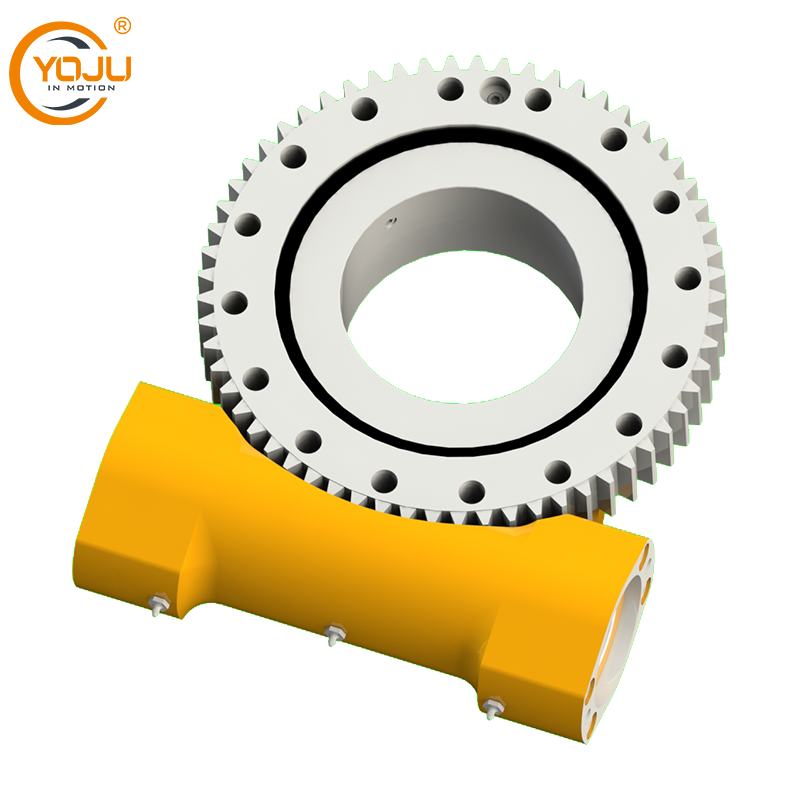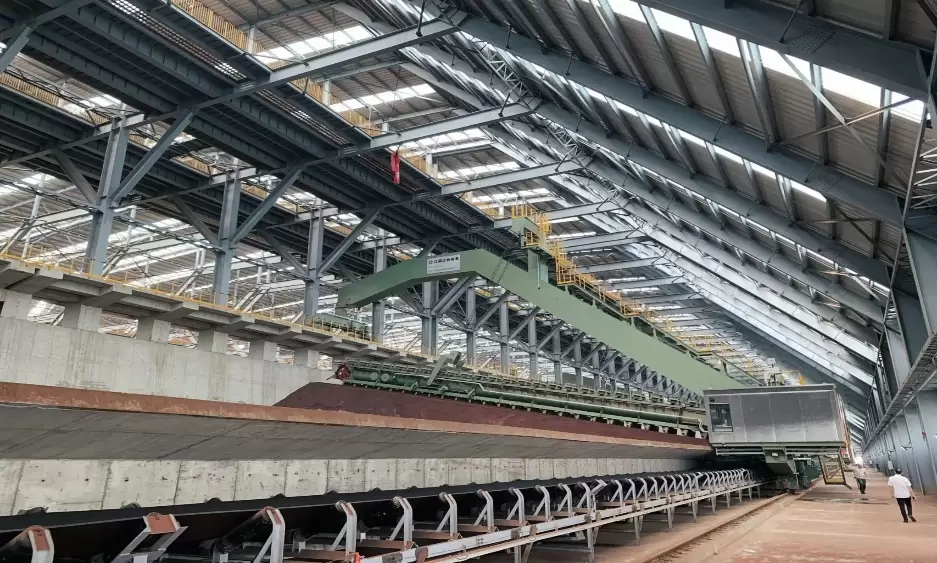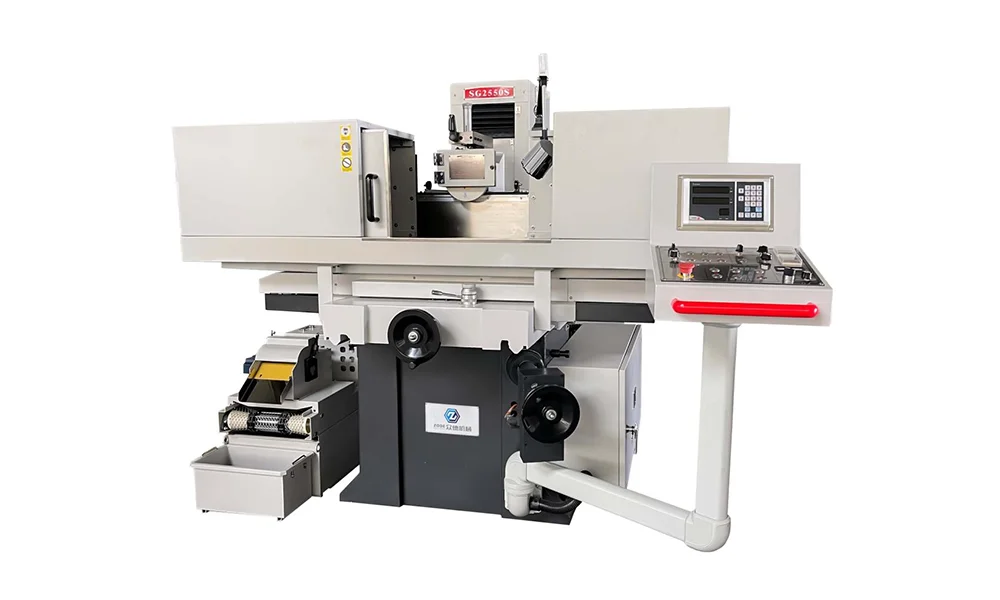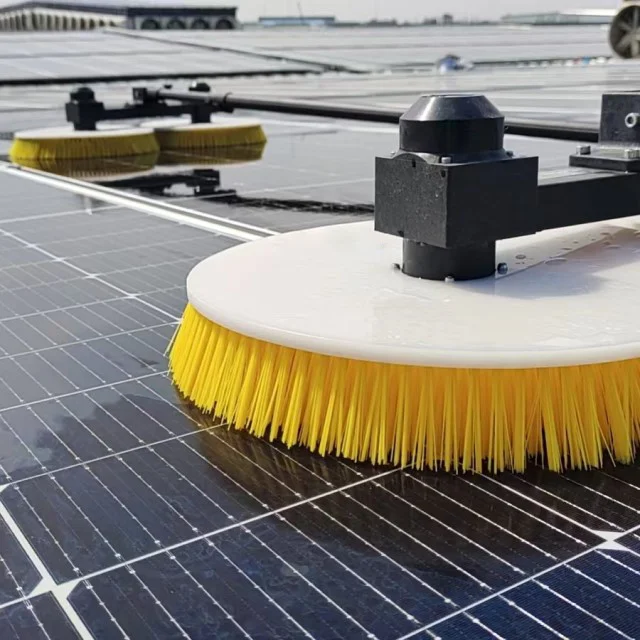Open housing slewing drives are pivotal in modern machinery, providing precise rotation and high load-bearing capacity for heavy-duty applications. With the rise of automated systems and heavy equipment, selecting the right slewing drive can significantly impact operational efficiency and longevity. In this blog post, as high performance custom slew drive manufacturing factory, YOJU will share the features of industrial open housing slewing drive, its applications, etc.
An industrial open housing slewing drive is a mechanical device that allows rotational movement between stationary and moving parts. Unlike closed housing designs, open housing slewing drives expose certain components, which simplifies maintenance and reduces weight, making them suitable for applications where accessibility and adaptability are critical.
These drives typically consist of a slewing bearing, a gear system, a motor interface, and a protective yet open frame. The bearing absorbs axial, radial, and tilting loads, while the gear system ensures smooth rotational motion. Open housing designs often enable direct inspection of gear teeth, lubrication points, and mounting interfaces.
Key Features of Open Housing Slewing Drive
Industrial open housing slewing drives combine mechanical robustness with operational flexibility. Key features include:
-
High Load Capacity: Designed to handle significant axial and radial loads, making them ideal for cranes, wind turbines, and excavators.
-
Compact and Lightweight: The open housing reduces overall mass without compromising structural integrity.
-
Ease of Maintenance: Exposed gears and bearings allow faster inspection and lubrication, reducing downtime.
-
Customizable Interfaces: Open housing designs accommodate various motor types and mounting configurations.
These features collectively enhance performance in applications that demand both strength and accessibility.
Industrial Applications of Open Housing Slewing Drive
Industrial open housing slewing drives find use across a range of heavy machinery and automated systems:
Construction Machinery
Cranes, excavators, and aerial platforms rely on slewing drives for precise rotational control. Open housing designs are particularly advantageous in these applications, where routine maintenance and quick access to components are essential.
Renewable Energy
Wind turbine yaw and pitch systems use slewing drives to adjust blade orientation. Open housing variants simplify installation and inspection, which is critical for turbines exposed to harsh environments.
Material Handling
Conveyors, rotary tables, and automated storage systems employ slewing drives for controlled rotation. Open housing models allow easy integration with existing systems and provide operational reliability under continuous loads.
Marine and Offshore Equipment
Deck cranes, winches, and platform rotators benefit from the corrosion-resistant coatings and open-access design of slewing drives, facilitating maintenance even in challenging offshore conditions.

Engineering Considerations for Open Housing Slewing Drive
Selecting and designing an industrial open housing slewing drive requires careful attention to several technical factors:
-
Load Analysis: Engineers must evaluate axial, radial, and tilting moment loads to determine appropriate bearing size and gear ratio.
-
Lubrication Strategy: Open housing drives need an effective lubrication plan to prevent premature wear, especially in dusty or wet environments.
-
Material Selection: High-strength steel, corrosion-resistant coatings, and heat-treated gears ensure durability and extended service life.
-
Precision Requirements: Applications with tight rotational accuracy require slewing drives with minimal backlash and optimized gear profiles.
Proper integration and preventive maintenance planning enhance the reliability and operational lifespan of the system.
Advantages of Industrial Open Housing Design
Open housing slewing drives offer several distinct advantages over enclosed counterparts:
-
Cost Efficiency: Reduced material usage and simplified assembly lower production costs.
-
Flexibility: Open designs accommodate non-standard mounting arrangements and custom motor interfaces.
-
Serviceability: Quick access to key components reduces downtime for inspection, lubrication, or part replacement.
-
Thermal Management: Open housing allows better heat dissipation, reducing the risk of overheating during continuous operation.
These advantages make them a preferred choice in sectors where performance, maintainability, and adaptability are equally important.
Challenges and Mitigation Strategies
Despite their benefits, industrial open housing slewing drives have some challenges:
-
Exposure to Contaminants: Dust, water, or debris can accelerate wear. Using protective covers and seals mitigates these risks.
-
Corrosion Risks: Open surfaces are more vulnerable to environmental factors. Selecting appropriate coatings and materials is critical.
-
Noise and Vibration: Open designs may transmit more operational noise. Careful gear design and damping measures help reduce vibrations.
Engineers must weigh these factors against application requirements to ensure optimal performance.
Maintenance Best Practices for Open Housing Slewing Drive
To maximize the life of an industrial open housing slewing drive:
-
Regularly inspect bearings, gear teeth, and lubrication points.
-
Apply appropriate greases or oils at recommended intervals.
-
Monitor load conditions and avoid exceeding rated capacities.
-
Address signs of wear or misalignment promptly to prevent cascading failures.
Routine maintenance ensures consistent performance and reduces the risk of unexpected downtime.
Future Trends in Industrial Open Housing Slewing Drive
With the growing demand for automation, Industry 4.0 integration, and renewable energy systems, open housing slewing drives are evolving:
-
Smart Monitoring Systems: Sensors embedded in slewing drives allow real-time monitoring of load, temperature, and vibration.
-
Lightweight Composites: Advanced materials reduce mass while maintaining load-bearing capacity.
-
Improved Gear Technology: High-precision, low-backlash gears enhance accuracy for robotic and precision applications.
-
Eco-Friendly Lubricants: Biodegradable lubricants reduce environmental impact during maintenance.
These trends point to smarter, more efficient, and environmentally conscious slewing drive solutions.
Conclusion
Industrial open housing slewing drives are indispensable in modern heavy-duty machinery, offering a balance of strength, accessibility, and operational flexibility. Their unique design enables ease of maintenance, high load capacity, and adaptability across diverse applications, from construction to renewable energy. By considering engineering requirements, maintenance practices, and environmental factors, industries can optimize the performance and lifespan of these critical mechanical components.
www.enyoju.com
YOJU


